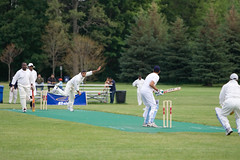The important 6%: How to be fit for cricket when it counts
On average, cricketers spend 94-96% of their time in the middle standing or walking, something most players capable of without training. But it's the 4-6% you need to be training for if you want to play your best. The trick is to get your training to reflect cricket: short duration bursts of very intense activity with a long recovery time.
However, cricket also requires different physical skills and to train each skill requires adjustments to the amount of time you recover for.
Below is a table that gives you the recovery times for each training method based on your particular goal. Use this table to adjust your own training to ensure you are working in the 4-6% range that cricket requires
Rest Times for Cricket Training
| Goal | Method | Btwn Sets | Btwn Workouts |
|---|---|---|---|
| Strength | Weights | 60-90s | 40-60h |
| Speed | Sprints | 3-5m | 30-40h |
| Power | Weights | 2-3m | 48-72h |
| Agility | SAQ Drills | 2-3m | 36-48h |
| Endurance | Intervals | 30-60s | 8-30h |
For more on the fundamentals of each skill please look at my complete guide to cricket fitness.
What about jogging to get for for cricket?
You will notice I did not mention long, slow jogging as a method here. If you are a regular reader you will know that this is because slow running simply does not represent the key 4-6% that we need to train. Some might argue that we need to jog to develop the 94-96% part of the game. In my view you would have to be very unfit to have to train yourself to stand and walk. Research has also shown that slow running slows you down. Not something you want when running a quick single.
Can fielding drills get me fit?
I have mentioned the power of fielding drills to get you fit in the past. They directly train the 4-6% in a perfectly specific way for fielding. The key to drills is to know what you are training for when you do them. You have 3 options:
- Speed/Agility. When training for speed/agility you need to ensure the distances covered are relatively short (20-40m) and the skill performed in the drill is simple to allow fielders to concetrate on running at full pace. The more direction changes the less straight speed and more agility is required. Recovery time for each person should be long (2m+) but a well designed drill can allow for this. A good rule of thumb should be that each player feels fully recovered before repeating the drill.
- Endurance (or work capacity). Compared to speed drills, these are done at below full speed and over longer distances (100m+). Due to the distance required the drill will usually have a run followed by a skill element followed by another run. Sudden direction changes should be minimal and recovery time should be much shorter (30-60s). Players should still be out of breath when repeating the skill.
- Technique. Technical drills should be much lower on intensity. Here the focus is improving the skill itself (throwing, catching, pickup, etc). There should be a large focus on the actual skill with very little emphasis on fitness. This method is the type used with younger players in group coaching sessions the most.
While the first 2 methods will improve your fitness (either speed, agility or endurance) for all skills it is still highly specific to fielding. If you also bat and/or bowl then you should not rely on fielding drills alone to get you fit. To really finish off your training ensure you are playing lots of practice games too as this will be the most specific way to get fit for cricket.
© Copyright miSport Holdings Ltd 2008
- Login to post comments



